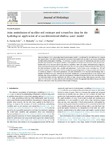Mostrar el registro sencillo del ítem
Joint assimilation of satellite soil moisture and streamflow data for the hydrological application of a two-dimensional shallow water model
| dc.contributor.author | García-Alén, Gonzalo | |
| dc.contributor.author | Hostache, Renaud | |
| dc.contributor.author | Cea, Luis | |
| dc.contributor.author | Puertas, Jerónimo | |
| dc.date.accessioned | 2023-10-11T17:48:11Z | |
| dc.date.available | 2023-10-11T17:48:11Z | |
| dc.date.issued | 2023 | |
| dc.identifier.citation | García-Alén, G., Hostache, R., Cea, L., Puertas, J. (2023). Joint assimilation of satellite soil moisture and streamflow data for the hydrological application of a two-dimensional shallow water model. Journal of Hydrology, 621, 129667. https://doi.org/10.1016/j.jhydrol.2023.129667 | es_ES |
| dc.identifier.uri | http://hdl.handle.net/2183/33760 | |
| dc.description | Financiado para publicación en acceso aberto: Universidade da Coruña/CISUG | es_ES |
| dc.description.abstract | [Abstract:] Data assimilation (DA) in physically-based hydrodynamic models is conditioned by the difference in temporal and spatial scales of the observed data and the resolution of the model itself. In order to use remote sensing data in small-scale hydrodynamic modelling, it is necessary to explore innovative DA methods that can lead to a more plausible representation of the spatial variability of the parameters and processes involved. In the present study, satellite-derived soil moisture and in situ-observed streamflow data were jointly assimilated into a high-resolution hydrological-hydrodynamic model based on the Iber software, using the Tempered Particle Filter (TPF) for the dual estimation of model state variables and parameters. Twelve storm events occurring in a 199 km2 catchment located in NW Spain were used for testing the proposed approach. A 3-step procedure was followed: (1) sensitivity analysis of the model parameters; (2) joint assimilation of soil moisture and discharge data to estimate correlations between observations and model parameters; (3) joint assimilation of soil moisture and discharge data using an initial set of particles and parameter standard deviations derived from prior information. The numerical model correctly reproduces the observed data, with an average Nash-Sutcliffe efficiency (NSE) value of 0.74 over the 12 events when the prior information is used. The approach described is shown to be most efficient with storm events that produce isolated peak discharges. | es_ES |
| dc.description.sponsorship | The authors acknowledge the support of Augas de Galicia and the Galicia Meteorological Agency (Metogalicia). Gonzalo García-Alén acknowledge the support of the INDITEX-UDC 2021 and 2022 Predoctoral Grants. The research reported herein was funded by the Luxembourg National Research Fund through the CASCADE (grant no. C17/SR/11682050) Project. Funding for open access charge: Universidade da Coruña/CISUG. | es_ES |
| dc.description.sponsorship | National Research Fund of Luxembourg; C17/SR/11682050 | es_ES |
| dc.language.iso | eng | es_ES |
| dc.publisher | Elsevier | es_ES |
| dc.relation.uri | https://doi.org/10.1016/j.jhydrol.2023.129667 | es_ES |
| dc.rights | Atribución-NoComercial-SinDerivadas 3.0 España | es_ES |
| dc.rights.uri | http://creativecommons.org/licenses/by-nc-nd/3.0/es/ | * |
| dc.subject | Hydrodynamic modelling | es_ES |
| dc.subject | Iber+ | es_ES |
| dc.subject | Flood forecasting | es_ES |
| dc.subject | Tempered particle filter | es_ES |
| dc.subject | Shallow water equations | es_ES |
| dc.subject | Data assimilation | es_ES |
| dc.title | Joint assimilation of satellite soil moisture and streamflow data for the hydrological application of a two-dimensional shallow water model | es_ES |
| dc.type | journal article | es_ES |
| dc.rights.accessRights | open access | es_ES |
| UDC.journalTitle | Journal of Hydrology | es_ES |
| UDC.volume | 621 | es_ES |
| UDC.startPage | 129667 | es_ES |
| dc.identifier.doi | 10.1016/j.jhydrol.2023.129667 | |
| UDC.coleccion | Investigación | es_ES |
| UDC.departamento | Enxeñaría Civil | es_ES |
| UDC.grupoInv | Enxeñaría da Auga e do Medio Ambiente (GEAMA) | es_ES |
| UDC.institutoCentro | CITEEC - Centro de Innovación Tecnolóxica en Edificación e Enxeñaría Civil | es_ES |
Ficheros en el ítem
Este ítem aparece en la(s) siguiente(s) colección(ones)
-
Investigación (ETSECCP) [826]






